DOMAIN • THREE
•KINGDOM Plantae•
Plant Non-Vascular:
Common name: Hypnum cupressiforme
Domain- Eukarya
Kingdom- Plantae
Division- Bryophyta
Class- Bryopsida
Subclass- Bryidae
Family- Hypnaceae
Genus- Hynum
Species- cupressiforme
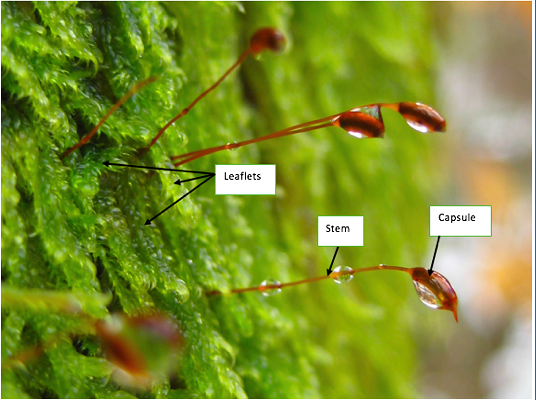
Figure 9a: Hypnum Cupressiforme Capsule.
In the picture above one can see the colors and the capsules of the moss Hypnum cupressiforme.
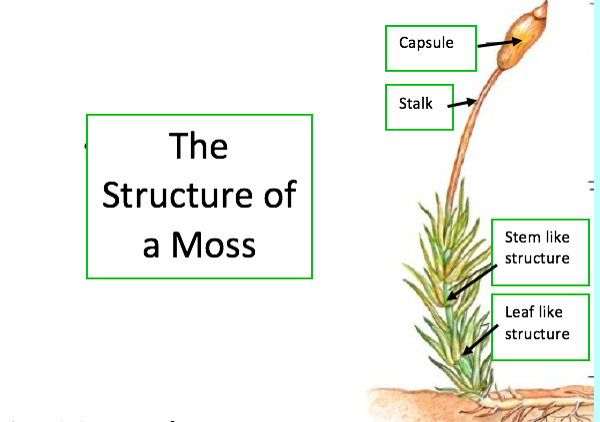
Figure 10a: Structure of a Moss.
In the picture above one can see the structure of a moss. One can see the capsule, stalk, stem-like and leaf-like structures.
Hypnum cupressiforme is a eukaryotic, non-vascular moss. This moss is also multicellular, non-motile, autotrophic and has no nervous system. This moss lives on all continents except for Antarctica. It will usually grow on tree trunks, logs, walls, rocks, and many acidic environments. It is 2-10 cm long, while the stem leaves are 1-1.2 mm by .3-.6 mm. The moss itself is leafy and gives off a rusty green appearance, however, the capsule is a brownish red and the stem is a yellowish-green. The stem is 1.8-2.5 mm and is also a little curved. The tip of this moss concaves and the branching stems are similar in shape to those of a Cypress tree [15a]. Hypnum cupressiforme, like almost all mosses, is not detrimental, and may even be beneficial. This moss attracts beneficial insects and will contain moisture. It does not feed off of the plant that it grows on. Similar to other plants, its mode of nutrition is photosynthesis [16a]. This plant will reproduce asexually through vegetative reproduction. It will produce capsules that will contain spores [15a]. This moss also creates a smooth and dense surface when it is wet.
Why it belongs in this Domain:
This moss has eukaryotic cells, and is a plant. This categorizes the moss under the domain Eukarya and the kingdom Plantae. It is under the division Bryophyte because it is a leafy type of moss. It is under the class Bryopsida because it produces capsules that contain spores. Due to the fact that it makes a dense surface, it falls under the family Hypnaceae. It is under the genus Hypnum because it is a sheet moss. This moss cannot be in domain Archaea because it cannot live in extreme environments, it does not have prokaryotic cells and is not unicellular. It is not in domain Bacteria because it is not motile, unicellular or prokaryotic.
Plant vascular gymnosperm:
Common name: Queen Sago
Domain- Eukarya
Kingdom- Plantae
Division- Cycadophyta
Class- Cycadopsida
Family- Cycadaceae
Genus- Cycas
Species- rumphii
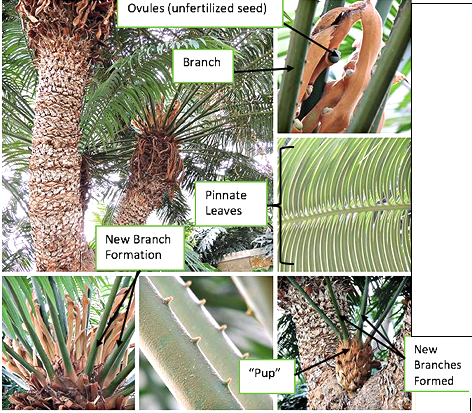
Figure 11a: Queen Sago Reproduction.
In the picture to the left one can see the different reproductive stages of the Queen Sago. In the top right image, one can see the green ovules forming. After the fertilization of the ovules, seeds are created. These seed grow and become similar to the bottom left image. In the lower right image, one can see the growth of the seed, in this stage it is referred to as the “pup.”
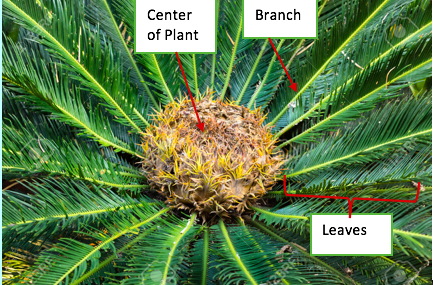
Figure 12a: Female Queen Sago.
In this image one can see the appearance of the female Queen Sago. One can also see the rounded and soft center containing the seeds, along with their dark green pinnate leaves.
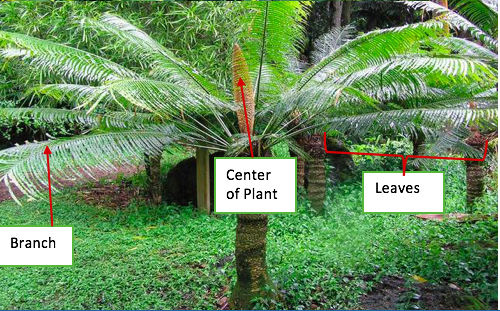
Figure 13a: Male Queen Sago
In this image one can see the appearance of the male Queen Sago.One can also see the center of the plant that is a cone-like structure. The center of the male plant contains the pollen needed to fertilize the seed from the female Queen Sago.
The Queen Sago is a multicellular, eukaryotic plant [17a] that grows in tropical areas [18a] such as South America, Central America, Mexico, Australia, Japan, China, Southeast Asia, India, and Madagascar [19a]. This tree has no nervous system and contains poisonous seeds [19a]. The seeds contain carcinogens and amino acids which can cause chronic nervous disorder [20a]. This tree is similar to and often mistaken as a palm tree, however, it is not considered a palm tree, it is considered a Cycad. This plant may have existed in the times of dinosaurs, meaning that it adapts well to new environments [19a].
Queen Sago is one type of tree that has separate male and female plants [19a]. Due to this, the female plant doesn't contain seeds in an ovary waiting to be fertilized [17a]. At the base of the female plant, the seeds lie waiting to be fertilized by the pollen from the male plant. The wind will carry the pollen, which then fertilizes the egg. One can see the different stages of this egg in Figure 9. As the seed develops it will look similar to a pineapple. The appearance of the female and male plant differ. The female plant has a rounded soft center while the male has an elongated upright cone-like structure [18a]. The leaves on this tree are approximately eight feet long and are dark green with a feather shape. This plant will receive the proper nutrients through photosynthesis [20a].
Why it belongs in this Domain:
Due to the fact that this organism is a eukaryotic plant, it is under the domain Eukarya and kingdom Plantae. The Queen Sago is in the division Cycadophyta because it produces seeds, has green and pinnate leaves, is a gymnosperm and is dioecious. It is in the class Cycadopsida because it grows in tropical areas and it is in the family Cycadaceae because it looks like a palm tree. It is in the genus Cycas because it grows along the equatorial region. This plant cannot be in the domain Archaea because it cannot live in extreme environments, it does not have prokaryotic cells and is not unicellular. It is not in domain Bacteria because it is not motile, unicellular or prokaryotic.
Plant vascular angiosperm:
Common name: Camphor Tree
Domain- Eukarya
Kingdom- Plantae
Division- Magnoliids
Order- Laurales
Family- Lauraceae
Genus- Cinnamomum
Species- camphora
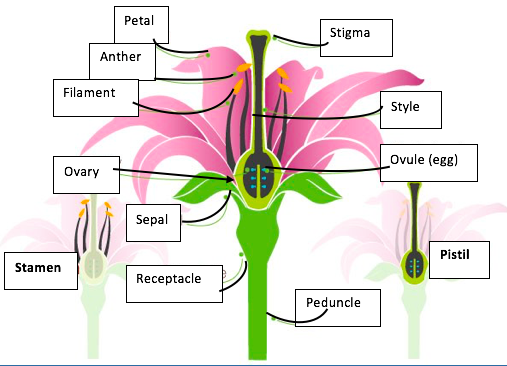
Figure 14a: Reproductive Organs in a Flower.
In the image above, one can see the male and female sex organs in a flower. The stamen is the male sex organ, this includes the anther, and the filament. The female sex organ is the pistil, this includes the ovary, the style, ovule and the stigma. The anther contains the pollen that will be blown by wind into the stigma, pass through the style and reach the ovules. In the Camphor tree, the ovules will not immediately be fertilized. The ovules will be fertilized when the seed is dropped after a bird has consumed the fruit produced by the flower.
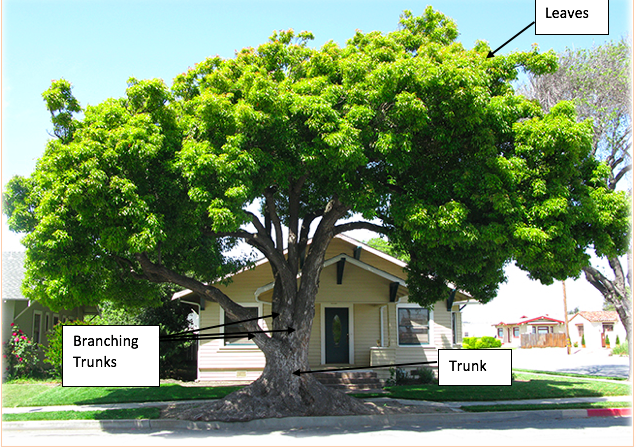
Figure 15a: Camphor Tree.
In the image above, one can see the basic overview of the Camphor tree. One can also the that the Camphor tree contains one main trunk which then divides up into smaller branching trunks.
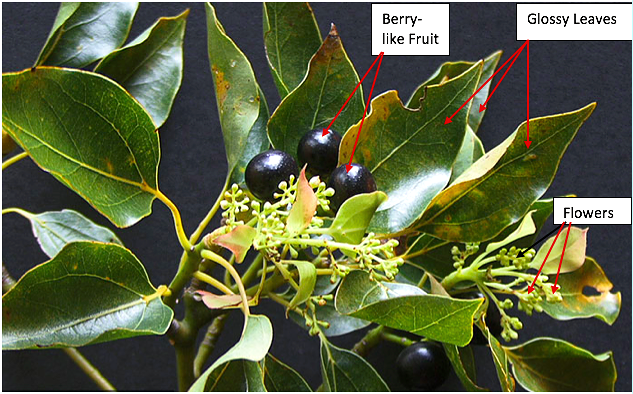
Figure 16a: Camphor Tree Leaves, Flowers, and Fruit.
In the image above one can the ripened fruit, white flowers and the glossy green leaves from the Camphor tree.
One type of tree that grows like a weed, has no nervous system, and can suppress native trees from producing seeds is the Camphor tree [22a]. This tree is native to China, Taiwan, Southern Japan, Korea, and Vietnam due to their subtropical climates. It can grow up to 26.8 meters tall [21a], has a trunk as big as 1.5 meters wide, and can live for hundreds of years [23a]. The Camphor tree has a light brown bark that feels rough, green leaves that appear waxy and are lighter on their bottom side, and has many white flowers that produce black fruit. These flowers hold both the male and female sex organs, which is shown in figure 12. The anthers will contain pollen. When the wind blows, pollen will be blown inside the stigma. However, in this tree, the pollen will not immediately fertilize the ovule due to a germination inhibitor. This inhibitor will prevent the ovule from being fertilized until the moment that it has the highest chance of surviving. In each fruit, there is one seed [22a]. This fruit will start off as a whitish-green color and move to a black shade. This will then inform birds that the fruit is ripe. The birds will eat the fruit and drop the seeds elsewhere, allowing the tree to grow in other locations [23a].
This tree, however, is considered detrimental to other plants. It will stop the production of seds in native trees as well as causing respiratory failure, nausea and vomiting to any organism that cannot properly process the chemicals its fruit produces [22a]. Therefore, the Camphor tree fruit are considered poisonous [23a]. The tree leaves give off a strong scent, which help to identify this tree. If one were to crush the leaves, one would be able to smell the strong odor, similar to menthol, from the leaves [22a]. One very interesting fact about this tree is that it has the ability to regenerate its branches if they are cut off or broken off [23a].
Why it belongs in this Domain:
Due to the fact that this organism is a plant with eukaryotic cells, it is under the domain Eukarya and kingdom Plantae. It is under the division Magnoliids because it is a flowering plant and under the order Laurales because it is a tree that produces flowers in subtropical climates. It is under the genus Cinnamomum because it is a weed. It is under the family Lauraceae due to the fact that the fruit produced from the flowers contains only one seed. This plant is not in domain Archaea or domain Bacteria because it is not unicellular, prokaryotic or motile.
Answer the following questions based on the paragraphs above.
DM